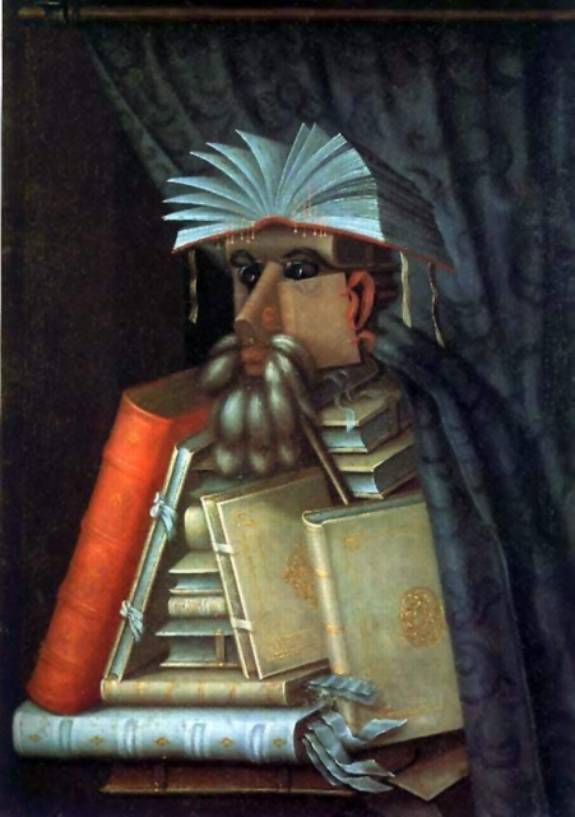
Consciousness, Literature and the Arts
Archive
Volume 6 Number 3, December 2005
___________________________________________________________________
Paranoiac-criticism, Salvador Dalí, Archibald and Superposition in Interpreting Double Images
by
The Surrealist Movement officially began with André Breton’s Surrealist Manifesto (1924). Originally this avant-garde movement
was concerned with Sigmund Freud’s psychoanalytic theories as a way to create
literature, primarily poetry, by unlocking the “marvelous.” This initial
phase of Surrealism was more concerned with literature than with art. The
primary debate of this early period centered on whether visual art could even be
Surrealist. As the 1920s progressed, the original group of Surrealist poets
expanded to include the fine arts, such as painting, sculpture, photography, and
a number of films were produced towards the end of the decade. By the end of the
decade, the answer was clearly “yes.” [I1]
In 1929, Salvador Dalí joined the Surrealist Movement; he would be
expelled almost a decade later. However, Dalí, especially in the United States,
is intimately connected to popular ideas of what Surrealism is and makes
something “surrealistic.” He derived his theory in equal parts from art
history and the art of paranoid schizophrenics,[i]
specifically those patients whose art exhibits multiple, composite images within
a single painting. It is this early theorization of a painterly Surrealism that
differs from the Surrealist poets. He called this theory the
“paranoiac-critical method”: it was derived from his reading and study of
the psychology of paranoia, particularly the art produced by paranoid
schizophrenics.
Art historian Dawn Ades, in
her discussion of Dalí’s deployment of optical illusions in his work, notes
that while these types of imagery are well known, they remain atypical of
Modernist approaches to art, and are the result of unknown processes[I2].
Thus, the multiple image is an area open to theorization:
Surrealism
was a significant part of a more general movement not only in psychoanalysis but
also in psychology and physics itself that questioned the empirical foundations
of knowledge and sought to understand the concealed mechanisms that condition
reality. [...] But the role of memory, or association and of cultural patterning
in what we see, or the eruption of hypnagagic images as we fall asleep, or the
delusional readings of the world in paranoia—and here we are squarely in the
terrain appropriated by Dalí—remain largely unexplained. [...] Modernism in
art is concerned with the abstract, the formal, the conceptual, and the pure
material object. Surrealism alone has systematically sought the interface
between internal and external realities, illusion and vision, perception and
thought.[ii]
Ades’
recognition of the parallels between Surrealism, psychology, and quantum physics
suggests that in the 1920s and 30s, a general paradigm shift was underway toward
an understanding of reality as explicitly different from what our senses present
as being. [I3]An
examination of linkages between these fields is therefore logical. This paper
proposes a theoretical model for understanding certain perceptual phenomena
called “multiple images”, drawing upon both Dalí’s paranoiac-critical
method and David Bohm’s later theorization in quantum physics. Contemporary
work by mathematician John Holland in complex adaptive systems (cas[I4]),
a method for mathematically modeling how an organism (singly or as a group) fits
itself to its environment, provides a model for links between the quantum
physics description of reality and the interpretative procedures Dalí calls
“paranoiac-critical”: the perception of multiple images.
‘Multiple images’ are a
particular type of optical illusion where the contents of the image are
ambiguous, allowing a series of discrete, unique visual interpretations of what
the image displays.
Understanding the
paranoiac-critical method requires an examination of the works of Dalí and the
Mannerist painter Arcimboldo [I5](figs.
1, 2), an earlier artist whose paintings of composite heads influenced all the
Surrealists, including Salvador Dalí. In the various Surrealist
Dictionaries Arcimboldo is identified as a Surrealist artist before
Surrealism existed. The examination of multiple images must also consider the
parallels between those images and other types of optical illusions, and outline
both schizophrenia and John Holland’s concepts of ‘rules’ and the
“bucket-brigade”—two key parts of his cas model.
Common to all multiple images
is the specific type of visual paradox built around ambiguous visual content in
the specific image. While Salvador Dalí was technically only a member of the
Surrealist Movement for a short period early in his career, his late work
“rethinks” the issues suggested in his paranoiac-critical theory in ways
that reveal an inherent difference with Surrealism. These differences imply the
possibility of a general theoretical model for visual phenomena.
The separation of Dalí from
the other Surrealists is implicit from his membership in the Surrealist Group.
His joining the moment was always problematic because his work as a painter
(arguments about appropriate subject matter) and as a theorist (a different
conception of Surrealist automatisme—the term employed by the Surrealists for autonomous
mental processes they would try to document in their work by using the clinical
tools of psychology such as “automatic writing” or word association)
challenged the forms of engagement with psychoanalysis used by his fellow
Surrealists. The more common approach to Surrealism followed by Breton et al.
was a presentational model where the artifacts produced may or may not describe
mental function. The form automatisme
took with Breton and the other Surrealist poets was based around word
association and (supposedly) undirected stream of consciousness writing. The
results of this procedure were evocative, but also extremely hermetic and
personally idiosyncratic, a description of a singular process: the poet’s.
In contrast to the literary,
word association-oriented approach to automatisme,
Dalí’s paranoiac-critical method is experiential instead of presentational.
Because the paranoiac-critical method creates images that, in principle, are
viewable by anyone, the images he creates allow an examination of autonomous
visual interpretative processes. These images present a particular kind of
ambiguity about their contents. His theory of multiple images provides points of
connection with the paradoxical indeterminacy known in physics as quantum
superposition—the coexistence of two independent, incompatible values, where
the collapse of the superposition into one state or the other is equally
probable.[I6]
Superposition is a good conceptual tool for describing the coexistence of
multiple images since their sudden shift from one image to another, completely
different one mirrors the sudden quantum “jumps” that superposition
describes.
Salvador Dalí’s
paranoiac-critical method proposes a systematic way of creating double images.
These pictures are a special form of paradox, one whose natural form is
experiential instead of logical; all double images propose a perceptual paradox
that “contains” two or more simultaneously discrete images visible to human
consciousness. This parallels quantum superposition, and like other optical
illusions, may be indirect evidence for superposition in the biology of the
brain.[iii]
[I7]The
defining feature of all double and multiple images is the viewer’s perceptions
oscillating between a set of potentials; it is also the most obvious
characteristic of paranoiac-critical imagery.
Dalí’s paranoiac-critical
method claims this oscillation mimics the associative process typical of
schizophrenic paranoia. He believes these visions are potential for all viewers.
These ideas form the foundation of his theory Surrealist automatisme:
Standing
altogether apart from the influence of the sensory phenomena with which
hallucination may be considered more or less concerned, the paranoiac activity
always employs materials admitting of control and recognition. It is enough that
the delirium of interpretation should have linked together the implications of
the images of the different pictures covering a wall for the real existence of
this link to be no longer deniable. Paranoia uses the external world in order to
assert its dominating idea and has the disturbing characteristic of making
others accept this idea’s reality. The reality of the external world is used
for illustration and proof, and so comes to serve the reality of the mind.[iv]
Dalí
is interested in the synthetic aspects of paranoid schizophrenia. He adapts from
this disease the paranoid’s ability to combine disparate and otherwise
unrelated materials through an illogical associative process based on
resemblance. Paranoids “bend reality” to their obsession—by assembling and
demonstrating a link that is not otherwise necessarily present. The “delirium
of interpretation” is this linking together by the “paranoid” mind; these
connections form the basis of Dalí’s theoretical procedure. A combination of
multiple interpretations—the separate images—superimposed over one another
is crucial to understanding how his “paranoid critical methodology” works.
As Dalí observes, it is not the actual sensory experience that concerns him but
the “internal” interpretations of experience by the observer; this interest
places his work in the realm of experiments with cognitive science as much as in
avant-garde art. The paranoiac-critical methodology is a systematic framework
for producing the same mental state in ‘normal’ viewers as found in
paranoids. The paranoiac-critical paintings allow normal individuals to see the
process of their own vision.
In the same way, optical
illusions reveal multiple images and demonstrate limits to the viewer’s
interpretative expertise: optical illusions are a type of visual paradox, just
as Dalí’s paintings are. The difference between the psychotic and the
‘normal’ individual lies in the individual’s ability to resolve these
paradoxes. The pathological mind cannot escape the contradiction central to any
paradox. The “movement” of these paradoxes in the individual’s vision is
the mind shifting between different possible interpretations, unable to resolve
the content of the picture. Dalí argues the oscillation these images exhibit is
equivalent to a psychosis:
The
way which it has been possible to obtain a double image is clearly paranoiac. By
double image it is meant such a representation of an object that it is also,
without the slightest physical or anatomical change, the representation of
another entirely different object, the second representation being equally
devoid of any deformation or abnormality betraying arrangement.[v]
This
theory finds a powerful illustration in Invisible
Sleeping Woman, Horse, Lion (1930) (fig. 3), one of the earliest canvases he
produced utilizing this concept. The precise content is ambiguous, but
constrained, as the title proposes. In looking at this painting, the viewer can
see a procession of distinct, yet coexisting, images—the sequence of
“invisibles” in the title. Each different interpretation exploits the
ambiguous potential of the pictorial elements; this oscillation of immanent
content requires the viewer’s internal interpretations to be inconsistent with
external reality. These shifts suggest perception undergoes a continuous
self-check or feedback, producing the transformations Dalí proposes as
“paranoiac-critical.” This visual superposition of imagery is one that
individuals can experience.
Dalí is correct both in his
identification of this superposition as equivalent to a psychosis, specifically
a form of schizophrenia, and in his claim that everyone is potentially capable
of seeing the shifts that identify the multiple image as such; as a result, the
individual is able to experience a superposition in the reality that is
experienced everyday. Dalí’s foundation for his theory is correct.
Schizophrenia is a pathological exaggeration of ‘normal’ mental function.’
In the original description of schizophrenia as a mental disease in 1912,
Eugen Bleuler concluded that its basis was a pathological
ambivalence that exaggerates typical situations into an irresolvable
conflict. In quantum physics, this conflict is called “superposition.”
Bleuler’s definition of this “ambivalence” is a mental paradox that
the dysfunctional mind cannot resolve:
(1)
Ambitendency, which sets free
with every tendency a counter-tendency.
(2)
Ambivalency, which gives to the
same idea two contrary feeling tones and invests the same thought simultaneously
with a positive and a negative character.[vi]
Pathological
ambivalence suggests
the development of an irresolvable inconsistency that forces the mind to adopt
other solutions than what ‘normal’ minds would employ. This possibility is
consistent with Bleuler’s observations of schizophrenia as a disease defined
by symptoms with no apparent psychological cause.[vii]
‘Normal’ thinking is ‘normal’ simply because it is the most common
successful adaptation to the environment. The schizophrenic has “lost” this
adaptive ability, making novel situations in experience problematic. Instead,
the schizophrenic adopts less-than-successful or inappropriate responses to new
situations. These “invented” responses mimic the creative response in every
way but one: the creative response is under the artists’ conscious control and
is chosen; the schizophrenic response is neither chosen nor consciously
controlled. Dalí’s paranoiac-critical method creates a situation where the
viewer can choose to experience the multiple images’ shifting—this element
is the key difference between his version of Surrealism and that of other
Surrealists.
The paranoiac-critical method
exploits low-level inconsistencies in the visual interpretations of the world.
The ambiguity of interpretation begins with “how” the optical illusion is
seen. It is determined by an autonomous (internal) interpretative decision about
the relationship between different parts of the image. Representational imagery
is contingent upon the combination of elements in preconscious processing of the
image. It is the process of creating relationships that determines what is seen.
In Invisible
Sleeping Woman, Horse, Lion (1930) (fig. 3), the decision that a series of
wavy lines are a woman’s hair directs the interpretation towards the sleeping
woman, while a different decision creates the horse, or the lion from the same
pattern of lines. At the same time, these “parts” can decompose from the
main subjects into a series of standing figures, both male and female, whose
identity is distinct from the composite. The relationships between these
components are unstable. In the blink of an eye, they can shift and become one
of the other “images” of this painting. All of these interpretations coexist
as potential images, each serving as an example of how the component parts could
be combined. As additional sets of relationships emerge, the oscillation
from one image to another becomes more complex. Invisible
Sleeping Woman, Horse, Lion demonstrates that the relationship between
abstraction and representation is largely a matter of the observer’s
interaction with the picture.
Dalí’s observations about the relationship between these cognitive
superpositions and ‘normal’ thinking and experience are implicit in
psychoanalyst Mark Garrison’s discussion of schizophrenia. Garrison argues
that when treating schizophrenics, psychologists should keep in mind the many
points of correlation between the thought processes employed in this pathology
and those that function in poetically inflected language and art.
He reiterates a point made by the Surrealists: that the difference
between pathology and ‘normal’ is a matter of degree, not of type.[viii]
As with Bleuler, Garrison’s
account of schizophrenic thinking places ambiguity
in a central position. Garrison views the indeterminate
character of the ambiguous as the cause of schizophrenia, a direct parallel to
the visual transformations of Dalí’s paranoiac-critical theory. The
difference between a pathological and ‘normal’ thought process arises from
how the ambiguity is “handled” by the interpreting mind. In schizophrenia,
ambiguity polarizes into ambivalence (superposition), blocking ‘normal’
solutions.
However, Garrison’s
retheorization of schizophrenia proposes a model for understanding how the mind
“solves” the problems posed by superposition through “opposition”—the
autonomous generation of negated interpretations. In ‘normal’ minds,
opposition changes ambiguity into either/or propositions, allowing the mind to
make a decision. This concept is identical to the process of John Holland’s
complex adaptive systems’ process of creating ‘rules.’
Holland believes calls the way subsequent interpretations strengthen
earlier ones by reusing them as their basis and support the
“bucket-brigade.” An early interpretation is much stronger than a later one,
but shifts in initial beliefs result in radically different outcomes. This model
provides an account of the function of Salvador Dalí’s paranoiac-critical
method. Changes in initial interpretations of relationships between the
component parts of an image are what cause Dalí’s visual shifts. These
transformations are evidence for a superposition resolving into a particular
outcome.[ix] This resolution to the
paradox causes the world to fall into recognizable order. Garrison’s
“opposition” makes sense of the world in ‘normal’ minds:
Opposition
solves not only ambivalence but also indecision, forcing an either/or decision
or no decision at all. Ambivalence occludes multiple alternatives, ambiguity,
and multiple meanings (polyvalence), forcing a dominating tension of opposites.
Ambivalence—pathologized—both shrinks the world into oppositions and
prevents (blocks) movement through it.[x]
Faced
with an array of equal potentials, the ambivalent nature of human perceptions
force an interpretative decision—even if that decision is later demonstrated
incorrect through trial and error. Without making that choice, there can be no
evolution towards successful interpretations. These successes derive from
testing past experience against immanent reality: thus, this model describes a
process of change, evolution and adaptation. Both ‘normal’ and
‘schizoid’ minds employ the same method, but the difference between one and
the other results from how the ambivalent nature of reality (adaptation to
inconsistency and superposition) is resolved.
Thinking in terms of
oppositions has an evolutionary advantage since it enables action without
certainty. Such ability is a characteristic of the testing employed by John
Holland’s complex adaptive systems
models where different interpretations or ‘rules’ compete:
The
‘rules’ can be viewed as hypotheses that are undergoing testing and
confirmation. On this view, the object is to provide contradictions rather than
to avoid them. That is, the rules amount to alternative, competing hypotheses.
When one hypothesis fails, competing rules are waiting in the wings to be tried.
… This credit-assignment procedure, which I call a bucket
brigade algorithm, strengthens rules that belong to chains of action
terminating in rewards. This process amounts to a progressive confirmation of
hypotheses concerned with stage setting and sub goals.[xi]
Holland’s
“rewards” are the physically measurable results of successful interactions
caused by the predictive capabilities of correct hypotheses about the
environment. The ‘rule’ and its interpretation “work.” Any action that
can be taken is learned through years of practice. This process of learning is
the “bucket brigade.” It is what happens when “the right choice” creates
the desired outcome. In the multiple images this “right choice” in how to
see the picture is indeterminate, thus it oscillates.
The
ability to encounter a consistent sensory world can clearly be modeled by cas’
model for approaching learned behavior. Physicist David Bohm’s view of
experience and interpretation expands this observation:
Thought
is a material process whose content is the total response of memory, including
feelings, muscular reactions and even physical sensations, that merge with and
flow out of the whole response. … All these are one process of response of
memory to each actual situation, which response in turn leads to a further
contribution to memory, thus conditioning the next thought.[xii]
The
result of Bohm’s description playing out in actuality
is Feedback. Dalí’s paranoiac-critical method implies this rechecking of
immediate experience as the foundation for the shifts in interpretation.
Feedback provides a check on the progress of Holland’s bucket-brigade,
allowing it to “reset” and start over in its strengthening of
interpretations. As a model for interpretation, this framework allows both
flexibility and varying degrees of probability in the interpretation of visual
phenomena, generating a range of possible approaches. It is a procedure where
regardless of the starting conditions, the process is a dynamic interchange
between observation, memory, and activity, It is also capable of the sudden
reordering and shifts in perception that are the basis of Dalí’s method.
Perceptions develop and are necessarily changed in response to changes in
reality. Less successful interpretations are necessarily refined to become more
successful.
Interpretation
is thus a procedure of continuous refinement that cannot ever reach
epistemological certainty: thus, Bohm argues that every interpretation should be
regarded as compromised by the historical circumstances of its formulation. His
interpretation implies that while reality does exist, the individual’s
internal model of the world is an abstraction that provides the necessary
information for survival within that unknowable reality. Bohm continues his
discussion by dividing interpretations
between those internal to the mind and those originating in sense encounter:
It
is clearly extremely important that no part of what originates in the response
of memory be missed or left out of awareness. That is to say, the primary
‘mistake’ that can be made in this field is not the [1] positive
one of wrongly assigning what originates in thought to a reality independent of
thought. Rather it is the [2] negative
one of overlooking or failing to be aware that a certain movement originates in
thought, thus implicitly treating that movement as originating in non-thought.[xiii]
Interpretations
of type [2] would be those ideas which are reified, those imaginary things an
interpreting mind treats as if they exist in the environment. The confusion Bohm
describes is an interpretative error—either confusing an interpretation for
reality or confusing the model for what it seeks to describe. The ability to
make this distinction is one of the key differences between ‘normal’ and
pathological thought processes described by Bleuler and Garrison.
Multiple images specifically
create a superposition in interpretations because observations of them in
reality are unstable. The nature of these images mislead the individual’s
sense perceptions so the feedback used to “check” perceptions forces a shift
in what the perceived image is. These shifts that define the multiple image.
The theoretical overlap
between Dalí’s paranoiac-critical method, schizophrenia, and superposition
can be generalized to be a broad model for visual interpretation. This extension
requires some clarification of the interpretative problematics of multiple
images. The optical illusion called a “Necker Cube” (fig. 4) simplifies the
complex movement of internal decisions seen in Dalí’s painting. The
orientation of this cube emerges from how it is placed in a virtual “space.”
Which ‘face’ of the cube is ‘up’ sets the context; this decision is made
almost unconsciously. In deciding the orientation of the cube, the viewer makes
the same representational decision as
in Dalí’s painting; this choice shapes the interpretation. The nature of
these double images forces the viewer to accept two (or more) incompatible
alternatives, bringing the decisions about the representation into
consciousness. Dalí calls this choice of context “desire”:
I
challenge materialists to examine the kind of mental attack which such an image
may produce. I challenge them to inquire into the more complex problem, which of
these images had the highest probability of existence if the intervention of
desire is taken into account; and also the problem, even graver and more
general, whether the series of these representations has a limit, or whether, as
we have every reason to think, such a limit does not exist, or exists as a
function of each individual’s paranoiac capacity.[xiv]
“Desire”
determines how perception changes sense-data into vision by constraining the
interpretation of that experience to organize what is seen in a specific
fashion; thus the process is “rational” even though the shifting through
associations is not. “Paranoiac
capacity” refers to each viewer’s natural ability to invent the potential
transformations of double images. This encounter is a mental experience, not a
physical change in the painting. The intellectual response makes an image
cohere. Because it is a process of interpretation, the limit Dalí proposes will
necessarily vary from individual to individual, depending on each person’s
specific experiences, memories, and propensity for the progression of different
interpretations from the same perceptual stimulus. Holland’s cas model
suggests this ability to see multiple images is a skill that can be learned and
improved with practice.
All double images exploit the
uncertainty in human interpretations of the world around; the shifts they
exhibit reveal the biological basis of perception. This form of image suggests
how perceptions have developed to generate the dynamic reality the individual
apparently inhabits but is unable to directly perceive. In examining optical
illusions (as with other kinds of paradoxes), the viewer becomes aware of the
limits of interpretative expertise.
What is visible in Invisible
Sleeping Woman, Horse, Lion (fig. 3) provides a structure for multiple
interpretations in much the same way that the collections of discrete objects in
the work of the Mannerist Arcimboldo (figs. 1, 2) form “composite heads.”
The semiotician Roland Barthes has examined Arcimboldo’s pictures, and his
observations can describe any painting of this type. While Barthes’ theory is
linguistic instead of perceptual, his observations about the process
of seeing apply to both theories:
Distance
and proximity are promoters of meaning. Everything proceeds from spacing out or
staggering of articulations. Meaning is born from a combination of
non-signifying elements (phonemes, lines); but it is not sufficient to combine
these elements to a first degree in order to exhaust the creation of meaning:
what has been combined forms aggregates which can combine again among themselves
a second, a third time.[xv]
Barthes
treats the various parts of the image as “signs” manipulated by the artist.
His metaphor—language—is useful in talking about multiple images because
language is not limited to a singular potential. It is the openness of double
images that allows Barthes’ metaphor. Nevertheless, Dalí and Barthes
recognize that the transformations occurring in multiple images require a basic
uncertainty in perception.[xvi] The interpretation of
visual information must be much less stable than it appears. Several
incompatible interpretations must simultaneously exist “in” a picture. The
shifts are indirect evidence of how interpretations of sense-data continually
hides some form of superposition in the environment. In multiple images, this
innate multiplicity becomes actual, instead of remaining potential.
Dalí’s theory is not
completely incompatible with Barthes. The difference between their theories is
that for Roland Barthes, human interpretations of all visual phenomena are a
form of language. Although his assumption does not pertain to Dalí, Barthes’
model also recognizes desire as the “device” of image revelation:
It
is the human subject that is asked to move. … It implies a relativization of
the space of meaning: including the reader’s gaze within the very structure of
the canvas … shifts from a Newtonian painting based on the fixity of objects
represented to an Einsteinian art according to which the observer’s movement
participates in the work’s status.[xvii]
Barthes’
“Einsteinian art” is closer to a quantum mechanical view of reality since
the observer “interacts” through the interpretation to shape the result.
This interaction of observer and subject determines the meaning of what is seen.
This is Barthes’ concept of “distance”, and it parallels Dalí’s own
commentary on the “function of each individual’s paranoiac capacity.”
Without inconsistency in interpreted observations and a feedback process
“checking” those observations, these apparent transformations would be
impossible. Double images are visual contradictions; they are paradoxes
experienced instead of logically deduced.
Even though Barthes is not
discussing Dalí’s work, Arcimboldo’s double images are one of Dalí’s
acknowledged sources for the paranoiac-critical image. The individual parts of
these heads are separate units in themselves, having their own details
completely distinct from the image generated by their arrangement. The separate
parts are also wholes. In double images, each “whole” is separated so the
individual identity is distinct from their combination. Each “whole” is seen
as a procession of images; these shifts are directly analogous to the collapse
of quantum superposition into specific states..[xviii]
However, these “positions” are not final, implying that even though the
perceptions present the viewer with apparently stable, discrete understandings
of the environment, its apparent stability is an illusion maintained
moment-to-moment. It can abruptly change. Multiple images create changes in
comprehension whose biological origins may be in the ability to identify
camouflage and simulated objects in the natural world. Reflected in these
oscillations is a mind actively engaged in placing itself in an environment
through a process of evaluation and re-evaluation of immediate sense-data.
Paranoid schizophrenics
interpret everything in the world according to their delirium, bending reality
to meet their specific needs; this is Dalí’s concept of ‘desire’ at its
pathological source. “Desire” however, does more than determine what image
appears first in Salvador Dalí’s theory. It is the controlling factor
directing the procession of images consciously and unconsciously.
“Desire” is the decisions the individual makes about how the parts
cohere. This Surrealist concept is automatisme
in action. The images seen are derived from the viewer’s own psychological
needs and wants. Where Dalí writes about a psychological “need,” Barthes
calls the same decision “distance”:
It
is by an effort of distance, by changing the level of perception, that I receive
another message, a hyper-metropic apparatus which, like a decoding grid, allows
me suddenly to perceive the total meaning, the “real” meaning. Thus
Arcimboldo imposes a system of substitution … and, in the same way a system of
transposition.[xix]
The
conscious choice of the observer in how to look at a composite head by
Arcimboldo determines what portion of that image appears as a component—for
example, a “nose”—and what the relationship between those components may
be—the formation of a face or the “disintegration” into other forms. When
interpretation focuses on the details as units complete in themselves, it
creates a radically different picture, independent of the head.
The
shift from one ‘level’ to another is no different that the movement between
the separate ‘images’ of Dalí’s work. Dissolution into the copulating
bodies of Invisible
Sleeping Woman, Horse, Lion corresponds to this separation of larger wholes
from smaller, but complete, parts in Arcimboldo’s heads. The “level”
Barthes describes is literal: how the totality of details in a painting are
understood to relate to one another allows the perception of different images.
The simplest example of this type of visualization is demonstrated by another
optical illusion called “Counterchange Faces” (fig. 5).
A
single line bisects a square in such a way that it describes two separate, but
linked, volumes. The decision about what is “volume” and what is “space”
determines which of the two potential faces-in-profile is seen. The
transposition of ‘volume’ and ‘space’ in the image generates
different—but equally valid—understandings of the picture. Dalí calls this
shifting interpretation “paranoiac-critical.” It is a movement between
necessarily contradictory understandings of an image where neither version can
be called “correct” or “incorrect.” In this regard, it is identical to
the Necker Cube and other double images.
Salvador Dalí’s The Slave Market with the Disappearing Bust of Voltaire (1940) (fig.
6) is considerably more complex than the “counterchange faces” but proceeds
through the same interpretative procedure. It is a more specific example of the
double image in Dalí’s work. Where Invisible Sleeping Woman, Horse, Lion leaves little room for other
imagery not connected to the multiple image, The Slave Market with the Disappearing Bust of Voltaire presents a
double image within a stable environment. The paranoiac-critical component has
become one feature of a larger picture. As with Barthes’ description of
Arcimboldo’s composite heads, this picture presents multiple images within a
limited set of relationships: the parts and the whole are separate, identifiable
objects that can be understood as totally distinct representations, independent
of one another.
The
bust of Voltaire is composed from a base and a pair of women standing together.
The location of these details within the composition as a whole creates their
dual role: a bust of Voltaire appears in one set of “details,” while a pair
of women standing beneath an arch appears in another. The shift between these
images is the formal focus of Dalí’s work:
The
truly paranoiac-critical moment comes when the calcified images begin to liquefy
and a stream of associations flows forth.[xx]
This
“burst” of associations proceeds “laterally,” each obscuring the
previous interpretation as it will be obscured by the next. Whatever meaning the
viewer finds for this canvas must include the de/composition of Voltaire and the
two women in the slave market. Meaning appears through the idea of the sequence
itself much more than within any singular image from that sequence—thus it
corresponds to a schizophrenic movement of association contained within
otherwise ‘normal’ perception.
The unfettered associations
rendered visible by the paranoiac-critical methodology differ from the
Surrealist idea of automatisme in one
crucial way: in automatisme, the
“dreaming” happens in the mind of the artist, is documented by the artwork,
and presented to an audience.[xxi] However, in Dalí’s
paranoiac-critical method and the art it produces, the audience is actively
creating the sequence of images, rather than passively receiving them. Dalí’s
method is a participatory Surrealism instead of a presentational one.[I8]
There is no distinction made between artist and audience in Dalí’s
theory. Typical automatisme is a private activity contained and controlled by the
poet writing separately from the audience reading. In a paranoiac-critical
image, the audience will inevitably repeat some aspects of the process the
artist used to generate these images. Dalí views this process as a type of
painting where the content remains virtual until someone looks:
The
new images which paranoiac thought may suddenly release will not merely spring
from the unconscious; the force of their paranoiac power will itself be at the
service of the unconscious.[xxii]
Andre
Breton’s definition of Surrealism as the unrestrained recording and
presentation of “pure psychic automatisme” posits a passive audience where
the consciousness on display is an artifact. The paranoiac-critical method takes
the passive recording of literary Surrealism and reverses it, creating an
active, participatory automatisme that
any viewer can see. [I9]Instead
of documenting this phenomenon, these paintings provoke an encounter with
psychosis while not actually having it; thus, it is a controlled psychosis; in
paranoiac-criticism, the act of looking becomes an experience shared by artist
and audience alike, demonstrating how the unconscious mind’s low-level
interpretations of the painting. Whenever one of these pictures “shifts,” it
is automatisme in action: the audience
in Dalí’s system participates in the Surrealist “game” as players instead
of observers of other’s “play.” His popularity and close linkage to the
vulgar concepts of “surrealistic” may be due to this more inclusive and
accessible version of automatisme. The
ability to see these images is shared by everyone to some degree. In Dalí’s
theorization and through his art, Surrealism becomes accessible to
non-Surrealists. Studying them teaches a different, more flexible, approach to
visual phenomena.
The paranoiac-critical
methodology exploits the viewer’s natural ability to visually interpret the
world around him/her. Generating optical illusions—paradoxes—is the point of
this process. These pictures, like Arcimboldo’s composite portraits, allow a
viewer to choose how the image is seen—what “level” of perception is of
interest. This adaptive process is specific to visual perception that relies on
and demonstrates superposition as an active presence in perceptions that remains
inaccessible to the viewer under normal circumstances.
Salvador Dalí’s
paranoiac-critical paintings belong to an early stage of his development. His
later works force a greater awareness of the role of perception in the apparent
subject and form of painting. The “distance” that both he and Barthes imply
as lying between different interpretations becomes a physical
feature of his late painting. In Ear with
Madonna (1958) (fig. 7), or Gala
Contemplating the Mediterranean Sea Which at Twenty Meters becomes the Portrait
of Abraham Lincoln (Homage to Rothko) (1976) (fig. 8), the vagaries of
eyesight play a central role in the visible content of the painting. Optical
distortion is the formal content of these works. They exploit the resolution of
the human eye to create their effects: physical proximity alters the
interpretation of image content. In describing Ear with Madonna, Dalí observes:
Quasi-gray
picture which, closely seen, is an abstract one; seen from six feet it is the
Sistine Madonna of Raphael; and seen from forty-five feet it is the ear of an
angel measuring five feet.[xxiii]
Both
images—the “Madonna” and the “ear”—are implicit, coexisting on one
canvas. The image of the Madonna is a network of lines and shadows with a moiré
pattern. The ear is depicted by the shape of the moiré pattern superimposed
over the Madonna. The shift from one to the other results from changes in real,
physical proximity—the scale of the image as determined by distance between
viewer and painting; as the size of the image decreases, the moiré pattern of
white dots become a substantial form, and the Madonna disappears. [I10]The
interpretative paradox of Dalí’s earlier paranoiac-critical images presents
the inconsistency in mental interpretation. In these later paintings, it becomes
literally physical space. This space is Barthes’ metaphor of ‘distance’
rendered visible. Apparent scale creates the interpretative effect as the
appearance of the canvas drastically changes as the observer approaches.
Physical location affects the ability to see one image or another. What Barthes
metaphorically describes as the motion of interpretation in understanding
multiple images is dramatized by these paintings.
The role of movement, vision,
and the interpretations of the environment become obvious through these
encounters. The viewer‘s decisions about what is seen are contingent upon
earlier and later interpretations. Dale’s late paintings reveal the underlying
uncertainties in those perceptions. It is clear from all his double images that
human understanding of the world collapses superpositions in a consistent
fashion; visual paradoxes make this collapse unstable: the images change one
moment to the next. The double images suggest the inconsistencies of
interpretation are physically latent in the individual’s senses and that the
observer’s encounter with the environment necessitates reevaluations and
reinterpretations of that environment. This procedure of reassessment suggests
that the senses themselves may be the reason viewers do not normally “see”
superposition. It is only under special circumstances—as in schizophrenia,
optical illusions, or art—that humanity experiences the presence of
superposition.
The paranoiac-critical method
uses innate abilities that are a side effect of perceptual process but, as
psychologist Anton Ehrenzweig noted in his study of art, this ability to see
shifts in multiple images, although innate, can remain undeveloped or potential
in certain kinds of rigid personalities.[xxiv]
Dalí’s theory demands a flexible mind in order to see these shifting images.
The formation of coherent images, in sequence, appear because each ‘set’ of
understandings is equally valid. (Seeing the image=successful interpretation.)
This concept is Holland’s “bucket brigade” in action.
Our senses’ apparent
consistency has obvious evolutionary advantages. However, when this consistency
ceases functioning in ‘normal’ ways, it becomes pathology. The paranoid
schizophrenic associative process is the reference point for Salvador Dalí
precisely because it is contagious: paranoid beliefs can be experienced by other
people who are not paranoid, thus allowing others to “see” in the same
fashion. That this methodology shares common features with optical illusions is
inevitable since both types of experience proceed from the same visual
inconsistency: placing superposition in a central role in the multiple image and
suggesting that consciousness and intelligence are linked to the processes
managing superposition in the individual’s perceptions.
This paper proposed a
preliminary theoretical model capable of producing the interpretative expertise
necessary for the mind’s construction of the consistent reality that is
encountered. Because it is an initial proposal of such a model, it is
necessarily limited by the scope of its presentation. The identification of a
visual superposition—the multiple image, as described by Dalí in the
paranoiac-critical methodology—provides a locus for further study. That the
salient points of this model can be generalized to all forms of visual
interpretation, and potentially beyond, is implicit in this argument. Instead of
representing a point of interpretative failure, superposition can identify those
places where the individual can examine the procedures and processes of
interpretation. Schizophrenia, multiple images, and other forms of paradox
should thus occupy a central position in the examination of interpretative
phenomena instead of being regarded as points of failure and conflicts to be
resolved. Dalí’s insistence that the paranoiac-critical method is a more
accurate way to encounter the world around us may be more than simply
avant-garde rhetoric.
[low
resolution copies of the Figure images follow]

Figure
1. The Librarian. This is a typical
composite portrait by Arcimboldo where the collection of objects combine to
create the impression of human form.
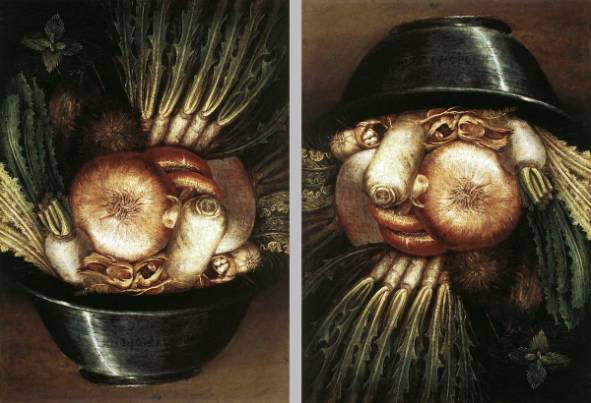
Figure
2. Two views of The Vegetable Cook.
Arcimboldo’s painting was designed to be exhibited with two orientations,
depending on the choice of the viewer. In one, the painting shows a still life
of a bowl of vegetables, in the other a portrait head.
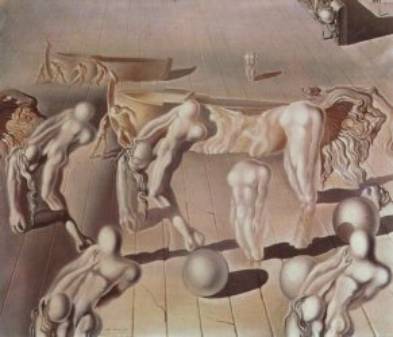
Figure
3. Invisible Sleeping Woman, Horse, Lion.
Dalí’s painting presents a series of component parts, erotically engaged,
whose positions in the image create a series of alternative paintings.
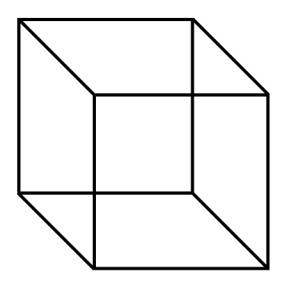
Figure
4. The Necker Cube. This optical
illusion was discovered in the nineteenth century by French chemist August
Necker who observed that salt crystals when seen under a microscope presented an
indeterminate cubic form.
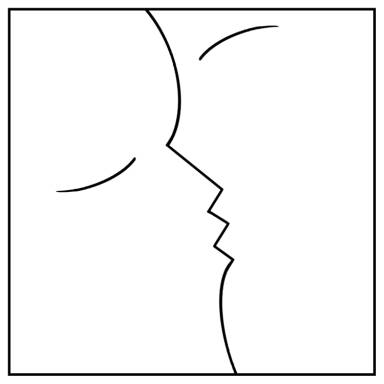
Figure
5. Counter-Change Faces. Optical
illusion of two kissing profiles that oscillate between what is called
“positive” and “negative” space in graphic design.
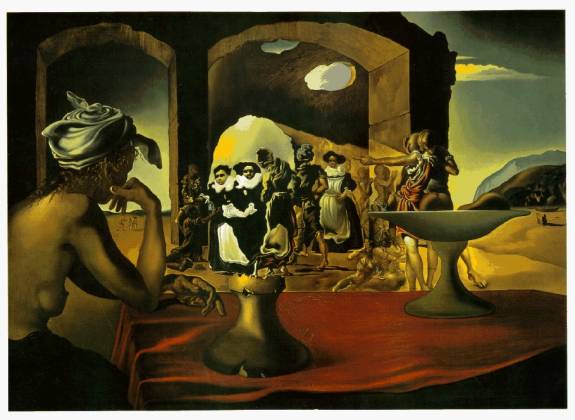
Figure
6. Slave Market with Disappearing bust of
Voltaire. The three centrally located figures in seventeenth century Dutch
clothes also comprise the face, with the archway outlining the top of the head
for the “invisible” bust of Voltaire.
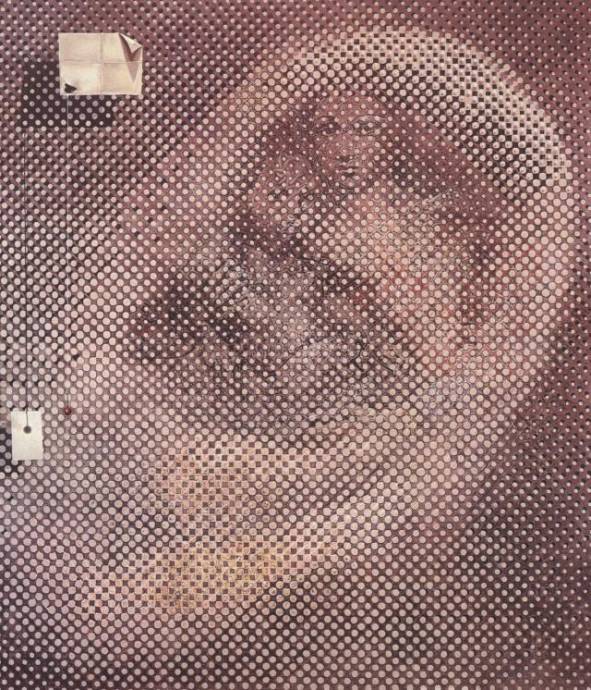
Figure
7. Ear with Madonna. As viewing
distance increases, the Madonna and child disappear, leaving the ear. At an
intermediate position, it is possible to see an oscillation between Madonna and
ear.
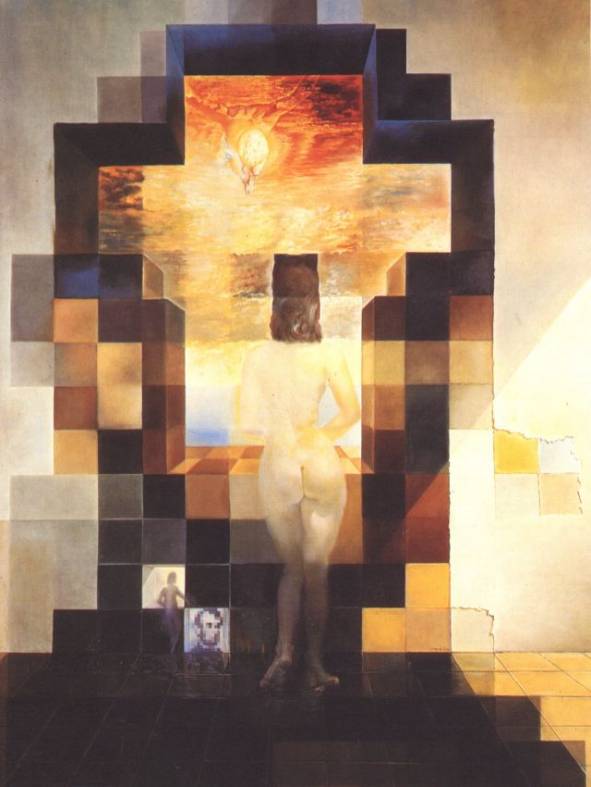
Figure
8. Gala
Contemplating the Mediterranean Sea Which at Twenty Meters becomes the Portrait
of Abraham Lincoln (Homage to Rothko). Along the
wall, to the left of Gala’s legs is a small picture of Lincoln that is
repeated as the overall image. This painting uses a pixilated image, generated
by computer as the basis for the Lincoln head.
[i] Cardinal, Robert. “Surrealism and the Paradigm of the Creative Subject” in Parallel Visions (Los Angeles: Los Angeles County Museum of Art, 1992), p. 108.
[ii] Ades, Dawn. Dalí’s Optical Illusions (Hartford: Yale University Press, 2000), p. 12.
[iii] Woolf, Nancy J. and Stuart Hameroff. “A Quantum Approach To Visual Consciousness,” in Trends in Cognitive Science Vol. 5, no. 11, November 2001, pp. 471-578, (specifically Box 3, p. 477).
[iv] Caws, Mary-Ann. The Surrealist Painters and Poets: An Anthology (Cambridge: The MIT Press, 2001), pp. 179.
[v] Ibid., p. 180.
[vi] Bleuler, Eugen. “Theory of Schizophrenic Negativism,” translated by William A. White, Journal of Nervous and Mental Disease, 1950, p. 266.
[vii]
Bleuler, Eugen. Dementia
Praecox, or the Group of Schizophrenias (New York: International
Universities Press, 1950), pp. 271-286.
[viii] Garrison, Mark. “The Poetics of Ambivalence” in Archetypal Psychiatry, spring 1982.
[ix] Bleuler, Op. cit., p. 477.
[x] Garrison, Mark. “The Poetics of Ambivalence” in Archetypal Psychiatry, spring 1982, p. 224.
[xi] Holland, John. Hidden Order: How Adaptation Builds Complexity (Reading: Perseus Books, 1995), pp. 53-56.
[xii] Bohm, Op. cit., pp. 50, 58.
[xiii] Ibid., p. 61.
[xiv] Dalí, Salvador. Oui (Boston: Exact Change, 1998), p. 180.
[xv] Barthes, Roland. The Responsibility of Forms (Berkeley: The University of California Press, 1985), p. 141.
[xvi] Barthes, op. cit., p. 131.
[xvii] Ibid., p. 142.
[xviii] Woolf, Nancy J. and Stuart Hameroff. Op. cit., pp. 471-578.
[xix] Ibid., p. 137
[xx] Dalí,, Op. cit., p.178.
[xxi] Breton, Andre. Manifestos of Surrealism (Ann Arbor: The University of Michigan Press), p. 27.
[xxii] Caws, Op. cit., p. 179.
[xxiii] Descharnes, Robert. Dalí, (New York: Abrams, 1984, 1997), p. 355.
[xxiv] Ehrenzweig, Anton. The Hidden Order of Art (Berkeley: University of California Press, 1967), p. 38.
[I1]This sentence would read better if it indicated that the “yes” applies to visual art
[I2]Unclear. Does the author mean that optical illusions are the same as multiple, composite images? I don’t think this is the case.
[I3]Quote just mentions physics, not quantum physics. I thought the early surrealists were more drawn to relativity than quantum theory. I may be wrong. If so, where does relativity fit?
[I4] Is this acronym commonly in lower case?
[I5]It would be helpful to add the dates of this artist’s life so the reader can place him.
[I6]Define quantum superimposition
[I7]How?
[I8]Nice.
[I9]Excellent
[I10]This is an excellent description and I would have liked to see something comparable when the earlier figures were introduced. I found it hard to see what the author was saying about Figure 3, for example. More detail to help the reader see the “map” would aid immensely.